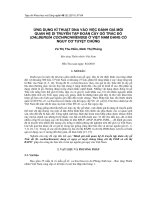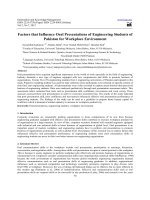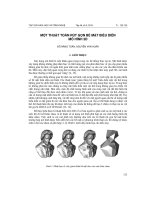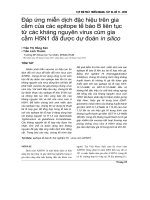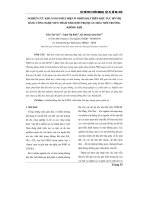4789-17229-1-PB
Bạn đang xem bản rút gọn của tài liệu. Xem và tải ngay bản đầy đủ của tài liệu tại đây (711.24 KB, 15 trang )
ŒCONOMICA
ISSN: 2065-0175
Investigating the Impact of Inflation on Foreign Direct Investment in
Southern Africa
Kunofiwa Tsaurai1
Abstract: This paper investigated the impact of inflation on foreign direct investment (FDI) and also
explored if financial development is a channel through which the impact of inflation on FDI in Southern
Africa could be moderated using panel data analysis. Under fixed effects, inflation was found to have
had a non-significant positive influence on FDI, random effects show that inflation negatively but nonsignificantly impacted on FDI whereas under the pooled OLS, inflation had a significant negative
influence on FDI in Southern Africa. Both fixed effects and pooled OLS found that the interaction
between inflation and financial development had an insignificant negative impact on FDI whereas
random effects framework shows that FDI was positively but non-significantly affected by the
interaction between inflation and financial development in Southern Africa. The policy implication of
the study is that Southern African countries needs to implement inflation lowering policies in order to
be able to attract FDI inflows. The study also urges Southern African countries to implement policies
that ensures a balance of low inflation environment and a developed financial sector in order to
sustainably ensure FDI inflows.
Keywords: Inflation; Financial Development; Foreign Direct Investment; Southern Africa
JEL Classification: E31; E44; F21; N17
1. Introduction
Background of the study: The contribution of FDI on economic growth is no longer
a disputable matter in finance and economics as emphatically supported by United
Nations Conference on Trade and Development (UNCTAD. 2017), UNCTAD
(2012), Calvo and Sanchez-Robles (2002), Romer (1986), Lucas (1988), Kumar and
Pradhan (2002), Solow (1956), Swan (1956) and Nath (2005). In summary, they
argued that FDI bring in additional capital, technology, skills, training of labor and
market access thereby enhancing the productive capabilities of firms in the host
country. It is the reason behind which the impact of FDI on economic growth has in
recent years received a lot of attention from empirical researchers and policymakers.
The chicken and egg question that is still far from being settled is: Does FDI
1
Associate Professor, Department of Finance, Risk Management and Banking, University of South
Africa, Address: P.O. Box 392, UNISA 0003, Pretoria, South Africa, Corresponding author:
AUDŒ, Vol. 14, no. 4, pp. 597-611
597
ACTA UNIVERSITATIS DANUBIUS
Vol 14, no 4, 2018
influence economic growth or it is economic growth which affects FDI? Although it
is quite clear from the ownership, location and internalisation (OLI) framework of
the eclectic paradigm hypothesis (developed by Dunning. 1973) that inflation is one
of the economic locational advantages of FDI, the direct inflation-FDI nexus has so
far been pursued by very few empirical researchers. The mixed findings on inflation
led FDI hypothesis observed by the few existing researchers on the subject matter
necessitated the current empirical investigation. Southern African countries deserve
a separate study on the relevancy of the inflation led FDI hypothesis because they
have got their own unique financial, economic, political and human capital
development characteristics that have a bearing on both inflation and FDI. Moreover,
the existing findings of a previous study on South Africa carried out by Valli and
Masih (2014) cannot be generalized for all the Southern African countries. The study
is useful to Southern African countries as it guides the crafting of inflation targeting
policies which are favourable to FDI and consequently economic growth.
Research gap and Contribution of the study: Majority of studies in the subject
matter have so far explored the impact of the complementarity between inflation and
FDI on economic growth and stayed away from investigating the direct impact of
inflation on FDI. Overwhelmingly, literature shows that inflation has a negative
impact on FDI. (Nnadi & Soobaroyen, 2015; Sayek, 2009; Andinuur, 2013;
Xaypanya et al, 2015) Despite the fact that the influence of financial development
on FDI is no longer a disputed matter as supported by Klein et al (2000), Guiso et al
(2004), Havrylchyk and Poncet (2007), Kaur et al (2013), Ezeoha and Cattaneo
(2012), no study has so far attempted to investigate the effect of the complementarity
between inflation and financial development on FDI to the best of the author’s
knowledge. Moreover, the few empirical studies on the direct impact of inflation on
FDI shows mixed and divergent views: (1) inflation has a positive impact on FDI,
(2) inflation negatively influence FDI, (3) there is no relationship between inflation
and FDI, (4) inflation and FDI complement each other in influencing economic
growth and (5) there is a feedback effect between inflation and FDI. Apart from a
study that was done by Valli and Masih (2014) on South Africa, no study on inflation
and FDI has been done on Southern Africa despite the fact the region comprises
some of the countries hardest hit by high levels of inflation and FDI fluctuations in
the recent history. It is against this backdrop that the current study seeks to
empirically investigate the relationship between inflation and FDI in Southern
Africa.
Organization of the paper: The remainder of the paper is organized into seven
sections. Section 2 discusses both theoretical and empirical literature on the impact
of inflation on FDI. Section 3 is the theoretical literature on the impact of financial
development on FDI. Section 4 describes the impact the other variables have on FDI
whereas section 5 is the research methodology (data description, pre-estimation
598
ISSN: 2065-0175
ŒCONOMICA
diagnostics, data analysis and interpretation). Section 6 summarizes the study,
section 7 provides the reference list while section 8 is the Appendix section.
2. The Influence of Inflation on Foreign Direct Investment – Literature
Review
There are three theoretical rationales which explains the impact of inflation on FDI:
(1) Nnadi and Soobaroyen (2015) and Andinuur (2013) observed that inflation is a
measure of macro-economic instability and that higher inflation rate could chase
away prospective and already existing foreign investors, (2) inflation rate increase
in host country reduces FDI as it erodes the value of the profits made by foreign
firms (Sayek, 2009, p. 423) and (3) low inflation reduces nominal interest rates and
consequently pushes down the cost of capital for foreign investors. On the contrary,
Obiamaka et al (2011) noted that it is possible that inflation in the host country can
have a positive impact on FDI inflows on condition that it does not exceed a certain
threshold level.
The different rate of return hypothesis developed by Popkin (1965) explains in an
indirectly way the relationship between inflation and FDI. It postulates that FDI is a
result of international differences in the real rates of return (inflation adjusted). The
theory says that FDI flows from countries whose investment real rate of return is low
into countries which are characterised by higher real rates of investment return.
Studies that supported the different rate of return hypothesis were done by few
authors. (Ali & Guo. 2005; Fedderke & Romm, 2006; Asiedu, 2002) In summary,
the theoretical framework says that a surge in marginal real rate of return (due to low
inflation) on foreign assets increases the ratio of the stock of foreign to domestic
capital holdings.
In a bid to test the theoretical framework, Fedderke & Romm (2006) studied the
impact of the net rate of return and risk on FDI location decision in South Africa
(SA) with annual aggregate time series data ranging between 1956 and 2003 using
vector error correction model (VECM). Higher net real rate of return, risk profile,
lower political risk, ensuring property rights, higher level of trade openness, lower
labour cost, lower corporate tax and bigger market size attracted FDI into SA, thus
supporting the different rate of return, eclectic paradigm and the market size
hypothesis. (Fedderke & Romm, 2006, 757) Moreover, exchange rate stability, low
inflation, labour cost and corruption levels were found to have had a positive effect
on FDI inflows in developing countries. (Kahai, 2004, p. 48)
Table 1 summarizes the empirical literature on the impact of inflation on FDI
599
ACTA UNIVERSITATIS DANUBIUS
Vol 14, no 4, 2018
Table 1. Inflation led foreign direct investment – Empirical literature
Author
Country/Countries
of study
Developing
and
developed countries
Methodology
Results
Panel
analysis
data
Valli
and
Masih (2014)
South Africa
Time
analysis
series
Alshamsi et al
(2015)
United
Emirates
Huybens and
Smith (1999)
None –Theoretical
literature
based
paper.
Inflation targeting had a more
significant positive impact on FDI in
developed than developing countries.
Inflation targeting was also found to
have had a more positive influence in
lower middle income developing
countries in comparison to upper
middle income developing countries.
No causality was found to exist
between inflation and FDI in South
Africa
Inflation was found to have had no
significant influence on FDI in the
United Arab Emirates
FDI was found to be a channel
through which inflation influences
economic growth.
Boyd et
(2001)
97 countries
Mason and
Vracheva
(2017)
al
Arab
Andinuur
(2013)
Ghana
Obiamaka et
al (2011)
Nigeria
Xaypanya et
al (2015)
ASEAN countries
Omankhanlen
(2011)
Nigeria
Sayek (2009)
Developing
countries
Amoah et al
(2015)
Ghana
Bibi
and
Rashid (2014)
Pakistan
Autoregressive
Distributive Lag
(ARDL)
None
–
Theoretical
literature based
paper.
Panel threshold
regression
analysis
Time
series
regression
analysis
Multiple
time
series regression
analysis
Multiple panel
regression
analysis
Multiple
time
series regression
analysis
Quantitative
analysis approach
Vector
Error
Correction Model
(VECM)
Dynamic
ordinary
least
squares
FDI influenced the impact
inflation on economic growth
of
Lower levels of inflation provided a
favourable economic environment
which in turn guarantees significant
FDI inflows into Ghana
Inflation rate had no influence on
FDI in Nigeria.
FDI was negatively influenced by
inflation in the ASEAN region.
Inflation was found to have had no
impact on FDI in Nigeria.
The negative influence of inflation in
the economy was found to have been
reduced by FDI inflows.
Both FDI and inflation were found to
have had no influence on each other
in Ghana.
FDI and inflation alongside trade
openness and stable exchange rates
played a critical positive influence on
economic growth in Pakistan.
Source: Author compilation
600
ISSN: 2065-0175
ŒCONOMICA
Quite conflicting findings are coming out from the summarised empirical literature
in Table 1. In fact, the findings can be divided into categories: (1) inflation has a
positive influence on FDI inflows, (2) there is no relationship at all between inflation
and FDI, (3) inflation and FDI complement each other in positively influencing
economic growth and (4) inflation influences FDI through some channels such as
financial development, among others.
3. The Impact of Financial Development on FDI –Theoretical Literature
Review
Theoretical literature on the influence of financial development on FDI is divided
into three groups, namely the liquidity easing, economic efficiency and allocative
channel perspectives. According to Antras et al (2009), shallow financial markets
reduces the number and level of foreign companies’ activities because they cannot
raise adequate capital from financial markets and have to over depend on finance
from the parent company. Empirical studies which supported the liquidity easing
perspective include Kholdy and Sohrabian (2008), Seghir (2009) and Levine (1997).
The economic efficiency perspective which was propagated by Bartels et al (2009)
argued that developed financial markets provide more efficient, timely and costcutting information to potential international investors thereby enhancing the flow
of FDI into the host countries. A study done by Shahbaz and Rahman (2010) found
out that the economic efficiency perspective was relevant in the case of Pakistan.
The allocative channel perspective which was supported by Kaur et al (2013), Klein
et al (2000), Havrylchyk and Poncet (2007) and Guiso et al (2004) says that
developed financial markets allocates scarce financial resources towards more
productive projects for economic growth thereby enhancing the productivity levels
of foreign capital. On the contrary, Hailu (2010) observed that in a developed
financial sector environment, foreign investors might opt for portfolio investment
rather than direct investments hence crowding out FDI. Financial development is
therefore expected to have either a positive or negative effect on FDI.
601
ACTA UNIVERSITATIS DANUBIUS
Vol 14, no 4, 2018
4. Other Variables that have an Impact on FDI
Table 2. Theory intuition and a priori expectation
Variable
Economic growth
(GROWTH)
Proxy used
GDP per capita
Trade openness
(OPEN)
Total of exports
and imports (%
of GDP)
Population
growth (POP)
Population
growth (annual
%)
Unemployment
rate (UNEMPL)
Total
unemployment
(% of total labour
force)
Theory intuition
The output and market size hypothesis
developed by Jorgenson (1963) argued that
FDI is positively attracted by the market size
of the host country as proxied by gross
domestic product (GDP) or gross national
product (GNP). The view was supported by
Moosa (2010: 483) who observed that a host
country characterised by larger market size as
proxied by its GDP attracts more FDI.
Denisia (2010) noted that location advantages
which influences FDI include economic,
political and social policies of the host country.
According to Denisia (2010:108), trade
openness is a political location advantage of
FDI within the eclectic paradigm hypothesis
which arises from unfavourable or favourable
government’s economic policies. On the other
hand, Baltagi et al (2009) argued that higher
levels of trade openness have a negative impact
on economic growth due to the fact that big
corporates choose to purchase their inputs
from abroad despite the fact that they could be
locally available.
Aziz and Makkawi (2012:66) explained that
large populations in the host country attract
FDI in three different ways: (1) provides a
large skill base, (2) provides a large market for
the products offered by the multinational
enterprise and (3) provide a large labour force.
On the theoretical front, high levels of
unemployment mean that the market size in
that particular host country is small thereby
dissuading the flow of FDI in line with the
market size hypothesis proffered by Jorgenson
(1963). On the other hand, high levels of
unemployment
attract
FDI
because
multinational enterprises will incur low labour
costs as the labour force can easily be replaced
if they demand unreasonable wages.
Expected sign
+
+/-
+
+/-
Source: Author compilation
5. Research Methodology
Data and Data Sources: The study used annual secondary data for Southern African
countries ranging from 1995 to 2014 which was extracted from International
Monetary Fund, World Bank, African Development Bank, World Development
Indicators and International Financial Statistics databases. The Southern African
countries included in the study include Zimbabwe, South Africa, Namibia,
602
ŒCONOMICA
ISSN: 2065-0175
Swaziland, Malawi, Mauritius, Mozambique, Madagascar, Seychelles and Tanzania.
Data availability considerations played a major part in the choice of the sample.
Pre-estimation diagnostics: In Table 3 (Appendix section), inflation and financial
development were separately found to be negatively but non-significantly correlated
with FDI whereas population growth and unemployment were individually found to
be positively related with FDI. As expected, a significant positive correlation
between (1) FDI and economic growth and (2) trade openness and FDI was detected
in the case of Southern African countries. All the findings are backed by theoretical
literature (refer to Table 3 - Appendix section). In line with Stead (1996), the
multicollinearity problem among the variables studied does not exist. This is because
the maximum correlation between any two variables is 65.67%, which coincides
with trade openness and economic growth.
In Table 4 (Appendix section), the standard deviation for inflation and economic
growth is 3 069 and 3 395 respectively, evidence that there exists abnormal or
extreme data in the two variables. Evidence that the data for all the variables is not
normally distributed lies in the fact that the probabilities of the Jarque-Bera criterion
is 0. To address these econometric issues, the current study first transformed the data
for all variables into natural logarithms before using it for main data analysis,
following Hair et al (2014).
Panel unit root and co-integration tests: Not all variables were significant at level
whereas all the variables were found to be significant at first difference (see Table 5
–Appendix section). In econometric terms, it means that all the variables were
stationary at first difference or integrated of order 1, a condition which should be
met before any co-integration tests are performed. Using Johansen Fisher Panel Cointegration test (see Table 6-Appendix section), the null hypothesis which says that
there is no co-integration among the variables is rejected. In other words, there are
at most six co-integrating vectors, a finding which shows the existence of a long run
relationship among the variables studied.
General and Econometric Model Specification: Following literature review
(section 2, 3 and 4), equation 1 represents the general model specification of the FDI
function.
FDI=f(INFL, FIN, GROWTH, OPEN, POP, UNEMPL)
[1]
In econometric terms and in line with the prime objective of the current study,
equation 1 is converted into equation 2.
FDI i ,t
0
1
INFLi ,t
2 X i,t i
Ɛit
[2]
603
ACTA UNIVERSITATIS DANUBIUS
Vol 14, no 4, 2018
Table 7. Signs and interpretations
FDI
INFL
X
i
Foreign direct investment as measured by net FDI as a ratio of GDP.
Inflation as proxied by inflation consumer prices (annual %).
Control variables and these include financial development, economic growth, trade
openness, population growth and unemployment rate.
Time invariant and unobserved country specific effect.
i
Country
t
Time
Ɛit
Error term
Intercept term
0
1
2
Co-efficient of inflation variable
Co-efficient of the control variables
Source: Author compilation
FDI i ,t 0 2 INFLi ,t 3 FIN i ,t 4 ( INFLi ,t . FIN i ,t )
5
GROWTH i ,t 6 OPEN i ,t 7 POPi ,t 8 UNEMPLi ,t i Ɛit
[3]
The interaction term ( INFLi ,t . FIN i ,t ) in equation 3 enabled the author to address
the second question: Is financial development a channel through which the negative
impact of inflation on FDI could be reduced or overturned? The theoretical
expectation is that financial development reduces the negative influence of inflation
on FDI.
Main Data Analysis: This stage involved estimating equations 2 and 3 using the
pooled fixed effects, random effects and pooled OLS, results of which are presented
in Table 8, 9 and 10 respectively.
Table 8. Fixed effects
Without interaction variable (Model 1)
Co-efficient
Std. Error
t-statistic
INFL
0.0104
0.0652
0.1604
FIN
-0.3002
0.4504
-0.6665
INFL.FIN
GROWTH
1.0620***
0.2574
4.1251
OPEN
0.5908*
0.3297
1.7920
POP
0.1201
0.1408
0.8531
UNEMPL
0.7825**
0.3920
1.9962
Adjusted R-squared 0.6514
F-statistic 7.19
Probability(F-statistic) 0.0000
With interaction variable (Model 2)
Co-efficient
Std. Error
t-statistic
0.0542
0.3006
0.1803
-0.2111
0.7491
-0.2818
-0.0335
0.2250
-0.1491
1.0640***
0.2585
4.1162
0.5907*
0.3306
1.7871
0.1187
0.1415
0.8389
0.7802**
0.3933
1.9838
Adjusted R-squared 0.6673
J-statistic 7.43
Probability(J-statistic) 0.0000
Source: Author’s compilation from E-Views
604
ŒCONOMICA
ISSN: 2065-0175
Notes: GDP per capita is the dependent variable. ***, ** and * denote 1%, 5% and 10%
levels of significance, respectively.
Under the fixed effects, inflation had a positive but non-significant impact on FDI in
both model 1 and 2, in line with Obiamaka et al (2011) whose study noted that it is
possible that inflation in the host country can have a positive impact on FDI inflows
on condition that it does not exceed a certain threshold level. Financial development
was found to have had a negative but insignificant influence on FDI in contradiction
to most theoretical explanations. The finding however resonates with Hailu (2010)
who argued that developed financial markets crowds out FDI as more foreign
investors are inclined towards portfolio investment rather than direct investments
participation. Although the impact of the interaction between inflation and financial
development on FDI was still negative and non-significant, the size of the interaction
term shows that inflation managed to reduce the negative impact of financial
development on FDI, consistent with Obiamaka et al’s (2011) argument.
Table 9. Random effects
Without interaction variable (Model 1)
Co-efficient
Std. Error
t-statistic
INFL
-0.0335
0.0634
-0.5277
FIN
0.3927
0.4280
0.9175
INFL.FIN
GROWTH
0.5353***
0.1971
2.7158
OPEN
0.3505
0.3108
1.1279
POP
0.1310
0.1385
0.9461
UNEMPL
0.0734
0.2615
0.2807
Adjusted R-squared 0.61
F-statistic 4.15
Probability(F-statistic) 0.0000
With interaction variable (Model 2)
Co-efficient
Std. Error
t-statistic
-0.0471
0.2964
-0.1589
0.4078
0.7268
0.5611
0.0164
0.2221
0.0740
0.6179***
0.2096
2.9479
0.3906
0.3164
1.2347
0.1278
0.1396
0.9156
0.1715
0.2885
0.5946
Adjusted R-squared 0.63
F-statistic 4.82
Probability(F-statistic) 0.0000
Source: Author’s compilation from E-Views
Notes: GDP per capita is the dependent variable. ***, ** and * denote 1%, 5% and 10%
levels of significance, respectively.
Under the random effects approach, inflation had a negative influence on FDI in line
with Sayek (2009) who explained that higher inflation in host country decrease FDI
inflows as it erodes the value of the profits made by foreign firms. On the other hand,
financial development was found to have had a non-significant positive impact on
FDI, a finding that resonates with the economic efficiency rationale (Shahbaz &
Rahman, 2010; Bartels et al., 2009) which says that a well-developed financial
market is better placed to decrease transaction costs incurred by foreign investors
and speed up the flow of information thereby attracting foreign FDI. Moreover, the
interaction between inflation and financial development had a non-significant
positive influence on FDI. As expected and in line with theoretical predictions, the
positive influence of financial development on FDI reduced the negative impact of
inflation on FDI.
605
ACTA UNIVERSITATIS DANUBIUS
Vol 14, no 4, 2018
The fixed and random effects approach also observed that trade openness played a
crucial role in positively influencing FDI in congruence with Denisia (2010)’s
propositions (see Table 2). Fixed effects approach found out that unemployment had
a significant positive impact on FDI whereas random effects had a non-significant
positive influence on FDI. The findings make theoretical sense because high levels
of unemployment mean that multinational enterprises can employ desperate labour
force in the host country at a low cost thereby attracting FDI. The theoretical
rationale resonates with the OLI framework of the eclectic paradigm hypothesis
proffered by Dunning (1973).
Table 10. Pooled OLS
Without interaction variable (Model 1)
Co-efficient
Std. Error
t-statistic
INFL
-0.1202*
0.0691
-1.7403
FIN
-0.8361**
0.3705
-2.2567
INFL.FIN
GROWTH
0.3251**
0.1480
2.1973
OPEN
-0.0104
0.2787
-0.0372
POP
0.1804
0.1514
1.1918
UNEMPL
-0.2206*
0.1240
-1.7790
Adjusted R-squared 0.54
F-statistic 5.72
Probability(F-statistic) 0.0000
With interaction variable (Model 2)
Co-efficient
Std. Error
t-statistic
-0.0398
0.3265
-0.1220
-0.6860
0.7021
-0.9772
-0.0612
0.2429
-0.2519
0.3187**
0.1505
2.1174
-0.0040
0.2805
-0.0144
0.1802
0.1518
1.1876
-0.2194*
0.1244
-1.7643
Adjusted R-squared 0.56
F-statistic 7.16
Probability(F-statistic) 0.0000
Source: Author’s compilation from E-Views
Notes: GDP per capita is the dependent variable. ***, ** and * denote 1%, 5% and 10%
levels of significance, respectively.
Under pooled OLS, both inflation and financial development had a separate
significant negative influence on FDI whereas the interaction between inflation and
financial development (model 2) had a non-significant negative effect on FDI in
Southern Africa. The finding means that host countries characterised by high levels
of inflation and financial development experiences negative outflows of FDI or finds
it difficult to attract FDI. The finding also implies that the interaction between high
inflation and high financial development reduces the rate of FDI outflows but does
not lead to net positive FDI inflows.
Under the pooled OLS framework, unemployment was found to have had a
significant negative influence on FDI. The finding is in line with Jorgenson’s (1963)
argument that high levels of unemployment shrinks the market size (number of
potential buyers of the products) in the host country thereby having a deleterious
effect on FDI. Supporting Baltagi et al (2009) who argued that trade openness has
an indirect negative influence on FDI through its deleterious influence on economic
growth, pooled OLS approach found out that trade openness affected FDI in a nonsignificant negative manner.
606
ISSN: 2065-0175
ŒCONOMICA
Economic growth had a positive and significant influence on FDI under the pooled
OLS, fixed and random effects in line with Jorgenson’s (1963) output and market
size hypothesis which argued that FDI is positively attracted by the market size as
proxied by GDP. Under the pooled OLS, fixed and random effects, population
growth had a non-significant positive impact on FDI in line with Aziz and Makkawi
(2012:66) whose study argued that large populations attract FDI into the host country
through provision of a large market, large skill base and large labour force.
6. Conclusion
This study had two major aims: (1) to investigate the impact of inflation on FDI and
(2) to explore the influence of a combination between inflation and financial
development on FDI in Southern Africa. Majority of available studies on the subject
matter have so far focused on the complementary effect of inflation and FDI on
economic growth and have shied away from investigating the direct impact of
inflation on FDI. It is against this background that the current paper investigated the
relevancy of the inflation led FDI hypothesis in Southern Africa.
Under fixed effects, inflation was found to have had a non-significant positive
influence on FDI, random effects show that inflation negatively but non-significantly
impacted on FDI whereas under the pooled OLS, inflation had a significant negative
influence on FDI in Southern Africa. The mixed findings are all backed by
theoretical explanations (see section 5.4). Both fixed effects and pooled OLS found
that the interaction between inflation and financial development had an insignificant
negative impact on FDI whereas random effects framework shows that FDI was
positively but non-significantly affected by the interaction between inflation and
financial development in Southern Africa. The overall policy implication of the
study is that Southern African countries needs to implement inflation lowering
policies in order to be able to attract FDI inflows. The study also urges Southern
African countries to implement policies that ensures a balance of low inflation
environment and a developed financial sector in order to sustainably ensure FDI
inflows.
7. Reference
Ali, S. & Guo, W. (2005). Determinants of FDI in China. Journal of Global Business and Technology,
Vol. 1, No. 2, pp. 21-33.
Aliber, R.Z. (1970). A theory of direct foreign investment. The International Corporation, Cambridge.
pp. 17-34.
Alshamsi, K.H.; Hussin, M.R.B. & Azam, M. (2015). The impact of inflation and GDP per capita on
foreign direct investment: the case of United Arab Emirates. Investment Management and Financial
Innovations, Vol. 12, No. 3, pp. 53-74.
607
ACTA UNIVERSITATIS DANUBIUS
Vol 14, no 4, 2018
Amoah, E.A.; Nyarko, E. & Asare, K. (2015). FDI, inflation, exchange rate and growth in Ghana:
Evidence from causality and co-integrated analysis. European Scientific Journal, Vol. 11, No. 31, pp.
294-304.
Andinuur, J. (2013). Inflation, foreign direct investment and economic growth in Ghana. MPhil
Economics Degree Dissertation, Unpublished. University of Ghana
Antras, P.; Desai, M.A. & Foley, F.C. (2009). Multinational firms, FDI flows and imperfect capital
markets. The Quarterly Journal of Economics, Vol. 124, No. 3, pp. 1171-1219.
Aziz, A. & Makkawi, B. (2012). Relationship between foreign direct investment and country
population. International Journal of Business and Management, Vol. 7, No. 8, pp. 63-70.
Baltagi, B.H.; Demitriades, P.O. & Law, S.H. (2009). Financial development, openness and institutions:
Evidence from panel data. Journal of Development Economics, Vol. 89, No. 2, pp. 285-296.
Bartels, F.L.; Alladina, S.N. & Lederer, S. (2009). Foreign direct investment in Sub-Saharan Africa:
Motivating factors and policy issues. Journal of African Business, Vol. 10, No. 2, pp. 141-162.
Bibi, S. & Rashid, H. (2014). Impact of trade openness, FDI, exchange rate and inflation on economic
growth: A case study of Pakistan. International Journal of Accounting and Financial Reporting, Vol.
4, No. 2, pp. 236-257.
Boyd, J.H.; Levine, R. & Smith, B.D. (2001). The impact of inflation on financial sector performance.
Journal of Monetary Economics, Vol. 47, No. 2, pp. 221-248.
Calvo, M.B. & Sanchez-Robles, B. (2002). Foreign direct investment, Economic freedom and
Economic growth: New evidence from Latin America. Universidad de Cartabria, Economics Working
Paper No. 4/03.
Denisia, V. (2010). Foreign direct investment theories: An overview of the main theories. European
Journal of Interdisciplinary Studies, Vol. 2, No. 2, pp. 104-110.
Dunning, J.H. (1973). The determinants of international production. Oxford Economic Papers, 25.
Ezeoha, A.E. & Cattaneo, N. (2012). FDI flows to Sub-Saharan Africa: The impact of finance,
institutions and natural resource endowment. Comparative Economic Studies, Vol. 54, No. 3, pp. 597632.
Fedderke, J.W. & Romm, A.T. (2006). Growth impact and determinants of foreign direct investment
into South Africa. Economic Modelling, Vol. 23, No. 5, pp. 738-760.
Guiso, L.; Sapienza, P. & Zingales, L. (2004). Does local financial development matter? The Quarterly
Journal of Economics, Vol. 119, No. 3, pp. 929-969.
Hailu, Z.A. (2010). Demand side factors affecting the inflow of foreign direct investment to African
countries: Does capital market matter? International Journal of Business and Management, Vol. 5, No.
5, pp. 103-112.
Hair, Jr.; Black, W.C.; Babin, B.J. & Anderson, R.E. (2014). Multivariate data analysis. Pearson New
International Edition. Seventh Edition.
Havrylchyk, O. & Poncet, S. (2007). Foreign direct investment in China: Reward or remedy? The World
Economy, Vol. 30, No. 11, pp. 1662-1681.
Huybens, E. & Smith, B. (1999). Inflation, financial markets and long run real activity. Journal of
Monetary Economics, Vol. 43, No. 2, pp. 283-315.
608
ISSN: 2065-0175
ŒCONOMICA
Im, K.S.; Pesaran, M.H. & Shin, Y. (2003). Testing unit roots in heterogeneous panels. Journal of
Econometrics, Vol. 115, No. 1, pp. 53-74.
Jorgenson, D.W. (1963). Capital theory and investment behaviour. The American Economic Review,
Vol. 53, No. 2, pp. 247-259.
Kahai, S.K. (2004). Traditional and non-traditional determinants of foreign direct investment in
developing countries. Journal of Applied Business Research, Vol. 20, No. 1, pp. 43-50.
Kaur, M.; Yadav, S.S. & Gautam, V. (2013). Financial system development and foreign direct
investment: A panel study for BRICS countries. Global Business Review, Vol. 14, No. 4, pp. 729-742.
Kholdy, S. & Sohrabian, A. (2008). Foreign direct investment, financial markets and political
corruption. Journal of Economic Studies, Vol. 35, No. 6, pp. 486-500.
Klein, M.W.; Peek, J. & Rosengren, E. (2000). Troubled banks, impaired foreign direct investment:
The role of relative access to credit. National Bureau of Economic Research Working Paper Series.
Cambridge, M.A, pp. 1-34.
Kumar, N. & Pradhan, J.P. (2002). FDI, externalities and economic growth in developing countries:
Some empirical explorations and implications for WTO negotiations on investment. RIS Discussion
Paper No. 27/2002. New Delhi, India.
Levin, A.; Lin, C.F. & Chu, C.S.J. (2002). Unit root tests in panel data: Asymptotic and finite-sample
properties. Journal of Econometrics, Vol. 108, No. 1, pp. 1-24.
Levine, R. (1997). Stock markets, economic development and capital control liberalisation.
Perspectives, Vol. 3, No. 5, pp. 1-7.
Lucas, R. (1988). On the mechanics of economic development. Journal of Monetary Economics, Vol.
22, No. 1, pp. 3-42.
Mason, R.L. & Vracheva, V. (2017). The impact of inflation targeting on attracting foreign direct
investment. Journal of Applied Business and Economics, Vol. 19, No. 4, pp. 79-94.
Moosa, I.A. (2010). International finance: An analytical approach. McGraw Hill Australia Pty Ltd, 3rd
edition.
Nath, H. (2005). Trade, Foreign direct investment and growth: Evidence from transition economies.
SHSU Economics and International Business Working Paper No. SHSU-Eco-WP05-04. Huntsville,
TX: Sam Houston State University.
Nnandi, M. & Soobaroyen, T. (2015). International financial reporting standards and foreign direct
investment: The case of Africa. Advances in accounting, Vol. 31, No. 2, pp. 228-238.
Obiamaka, P.E.; Onwumere, J.U. & Okpara, G.C. (2011). Foreign direct investment and economic
growth in Nigeria: A granger causality analysis. International Journal of Current Research, Vol. 3, No.
11, pp. 225-232.
Omankhanlen, A.E. (2011). The effect of exchange rate and inflation on foreign direct investment and
its relationship with economic growth in Nigeria. Fascicle I. Economics and Applied Informatics, Vol.
17, No. 1, pp. 5-16.
Popkin, J. (1965) ‘Interfirm differences in direct investment behaviour of U.S. Manufacturers’, Ph.D
Thesis, University of Pennsylvania.
Romer, P. (1986). Increasing returns and long run economic growth. Journal of Political Economy,
Vol. 94, No. 5, pp. 1002-1037.
609
ACTA UNIVERSITATIS DANUBIUS
Vol 14, no 4, 2018
Sayek, S. (2009). Foreign direct investment and inflation. Southern Economic Journal, Vol. 76, No. 2,
pp. 419-443.
Seghir, S. (2009). Does foreign direct investment impact the financial stability or conversely: The case
of Tunisia? A gravity model approach’, Investment Management and Financial Innovations, Vol. 6,
No. 1, pp. 96-100.
Shahbaz, M. & Rahman, M.M. (2010). Foreign capital inflows-growth nexus and the role of domestic
financial sector: An ARDL co-integration approach for Pakistan. Journal of Economic Research, Vol.
15, No. 3, pp. 207-231.
Solow, R. (1956). A contribution to the theory of economic growth. Quarterly Journal of Economics,
Vol. 70, No. 1, pp. 65-94.
Stead, R. (1996). Foundation quantitative methods for business. Prentice Hall. England.
Swan, T. (1956). Economic growth and capital accumulation. The Economic Record, Vol. 32, No. 2,
pp. 334-361.
UNCTAD (2012). World Investment Report. New York: United Nations.
UNCTAD (2017). United Nations Global Investment Trends monitor Number 25, 1 February 2017, pp.
1-8.
Valli, M. and Masih, M. (2014) ‘Is there any causality between inflation and FDI in an inflation
targeting regime? Evidence from South Africa’, Munich Personal RePEc Archive Paper Number
60246.
Xaypanya, P.; Rangkakulnuwat, P. & Paweenawat, S.W. (2015). The determinants of foreign direct
investment in ASEAN. The first differencing panel data analysis. International Journal of Social
Economics, Vol. 42, No. 3, pp. 239-250.
8. Appendix Section
FDI
INFL
GROWTH
FIN
OPEN
POP
UNEMPL
FDI
1.00
-0.0547
0.2477***
-0.0021
0.2560***
0.0579
0.0112
INFL
1.00
-0.0781
0.0656
0.0038
-0.0633
-0.0779
Table 3. Correlation analysis
GROWTH
FIN
1.00
0.6003***
0.6567***
-0.5868***
0.0044
1.00
0.3026***
-0.6245***
0.0233
OPEN
1.00
-0.5946***
0.0359
POP
UNEMPL
1.00
0.0960
1.00
Source: Author compilation from E-Views
Note: ***/**/* denotes statistical significance at the 1%/5%/10% level respectively.
610
ŒCONOMICA
ISSN: 2065-0175
Table 4. Descriptive statistics
Mean
Median
Maximum
Minimum
Standard. deviation
Skewness
Kurtosis
Jarque-Bera
Probability
Observations
FDI
4.73
2.91
54.1
0.01
6.68
4.09
24.7
4498
0.00
200
INFL
323.99
7.21
36012
0.01
3068
10.36
111.6
101903
0.00
200
GROWTH
2906.5
1129
15687
142.3
3395
1.47
4.68
95.4
0.00
200
FIN
3.41
3.34
5.26
0.53
1.06
-0.04
2.21
5.24
0.07
200
OPEN
38.91
31.87
107.99
10.2
20.75
1.09
3.63
42.58
0.00
200
POP
1.97
2.01
3.52
0.01
0.93
-0.32
1.86
14.30
0.00
200
UNEMPL
12.78
7.45
37.6
1.30
9.70
0.47
1.60
23.85
0.00
200
Source: Author compilation from E-Views
Table 5. Panel unit root tests –No Trend and Intercept
FDI
INFL
GROWTH
FIN
OPEN
POP
UNEMPL
Level
LLC
-1.9535**
-2.6933***
4.1812
1.5338
-0.3255
-1.4506*
0.6997
IPS
-
ADF
57.08***
43.1812***
2.0935
8.9311
8.8225
48.7196***
11.9136
PP
95.47***
49.375***
1.2017
10.5471
10.1168
40.4534***
13.1281
First difference
LLC
-12.8728***
-13.2253***
-7.7968***
-8.1147***
-10.4504***
-7.7513***
-9.4378***
IPS
-
ADF
166.022***
159.135***
87.5228***
93.7077***
132.285***
106.951***
115.093***
PP
180.71***
184.651***
126.463***
175.795***
168.692***
120.33***
174.389***
Source: Author’s compilation from E-Views
Note: LLC, IPS, ADF and PP stands for Levin, Lin and Chu; Im, Pesaran and Shin; ADF
Fisher Chi Square and PP Fisher Chi Square tests respectively. *, ** and *** denote 1%, 5%
and 10% levels of significance, respectively.
Table 6. Johansen Fisher Panel Co-integration test
Hypothesised
No. of CE(s)
None
At most 1
At most 2
At most 3
At most 4
At most 5
At most 6
Fisher Statistic (from
trace test)
13.86
9.70
2.77
184.2
238.8
91.47
52.17
Probability
0.8374
0.9732
1.0000
0.0000
0.0000
0.0000
0.0001
Fisher Statistic (from maxeigen test)
13.86
64.97
150.1
184.2
188.3
74.46
52.17
Probability
0.8374
0.0000
0.0000
0.0000
0.0000
0.0000
0.0001
Source: Author’s compilation from E-Views
611
